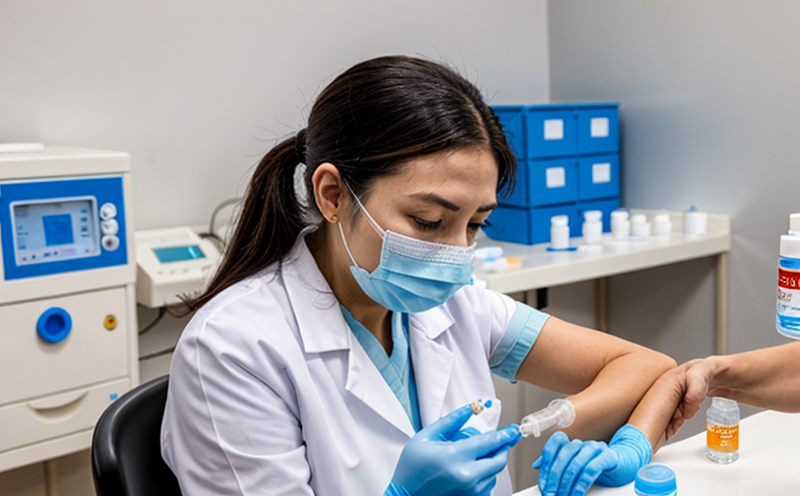In Vivo Challenge Testing of Live Vaccines
Understanding in vivo challenge testing is crucial for ensuring that live vaccines are safe and effective. This type of testing involves exposing a subject to the pathogen against which the vaccine is designed, thereby assessing its ability to provide protection. In this context, pharmaceutical companies must adhere to rigorous standards to ensure public health. The process is not only vital for regulatory compliance but also essential for building confidence in vaccine efficacy.
The first step in conducting in vivo challenge testing involves selecting the appropriate animal model and preparing the subject properly. This may include acclimating the animals to minimize stress, which can affect test outcomes. Specimen preparation is equally critical; it ensures that the vaccine administered behaves predictably under challenging conditions. The choice of animal species, strain, and age must align with the target human population for accurate results.
Once prepared, the subjects are exposed to a known dose of pathogen. This can be conducted in various environments depending on the specific requirements and regulatory guidelines. Post-exposure monitoring is essential to observe any signs or symptoms indicative of disease. Throughout this period, detailed data collection is imperative. This includes recording physical parameters such as temperature, body weight, and activity levels; clinical signs like lethargy, ruffling fur, or diarrhea; and laboratory results for markers of infection.
After the challenge phase, efficacy assessment follows by evaluating the vaccinated subjects against unvaccinated controls. The comparison helps determine if the vaccine has provided sufficient protection. Successful outcomes are characterized by reduced severity or incidence of disease in vaccinated groups compared to those without vaccination. This comprehensive approach ensures that only safe and effective vaccines reach clinical trials and ultimately the market.
Regulatory bodies worldwide demand stringent quality assurance measures during in vivo challenge testing. Compliance with these standards enhances product safety and reliability, thereby fostering trust among consumers and healthcare providers. Adherence to international guidelines such as ISO, ASTM, EN, IEC, and FDA regulations underscores the importance of meticulous adherence to protocols.
Why It Matters
In vivo challenge testing is a cornerstone of vaccine development and quality assurance processes because it directly evaluates the real-world performance of vaccines. By subjecting vaccinated animals to actual pathogens, this method provides insights into how well the vaccine works under conditions that closely mimic natural infections.
- Enhanced Safety Assessment: This testing allows for early detection of potential adverse reactions or side effects.
- Predictive Efficacy: It helps in understanding whether the vaccine can effectively prevent disease when faced with real-world challenges.
- Regulatory Compliance: Adherence to international standards ensures that the testing meets stringent quality and safety requirements, which is critical for regulatory approval.
The results of these tests are instrumental in guiding further development efforts. They inform modifications needed based on observed shortcomings or improvements seen during the challenge phase. This iterative process ultimately leads to safer and more effective vaccines.
Moreover, the outcomes from such testing contribute significantly to public health strategies by providing reliable data that can be used to prioritize vaccination programs effectively. Ensuring robust vaccine performance through rigorous in vivo challenge testing contributes to global efforts towards eradicating infectious diseases.
Scope and Methodology
In vivo challenge testing involves several key components, each designed to ensure accurate assessment of the vaccine's protective efficacy:
| Component | Description |
|---|---|
| Animal Selection | The choice of species and strain must reflect the target human population. Common choices include mice, hamsters, or guinea pigs. |
| Preparation | This includes acclimation to reduce stress and proper handling techniques for specimen preparation. |
| Challenge Administration | The pathogen is introduced in a controlled manner to mimic natural exposure scenarios. |
| Efficacy Assessment | This involves comparing vaccinated subjects with unvaccinated controls, observing clinical signs and laboratory data. |
Each step requires careful planning and execution to ensure that the test accurately reflects real-world conditions. Compliance with international standards ensures consistency across different laboratories and enhances reliability of results.
International Acceptance and Recognition
- The World Health Organization (WHO) endorses in vivo challenge testing as a critical component of vaccine evaluation.
- European Medicines Agency (EMA) guidelines emphasize the importance of such tests for assessing vaccine safety and efficacy.
Countries like the United States, Canada, Australia, and various member states within the European Union have stringent regulations that mandate compliance with these international standards. These regulatory bodies review data from in vivo challenge testing to ensure vaccines meet high safety and effectiveness criteria before approval.
Recognizing the global nature of healthcare challenges, adherence to these internationally accepted practices fosters collaboration among researchers and pharmaceutical companies worldwide. This cooperation is essential for developing effective solutions that can be deployed globally against infectious diseases.





